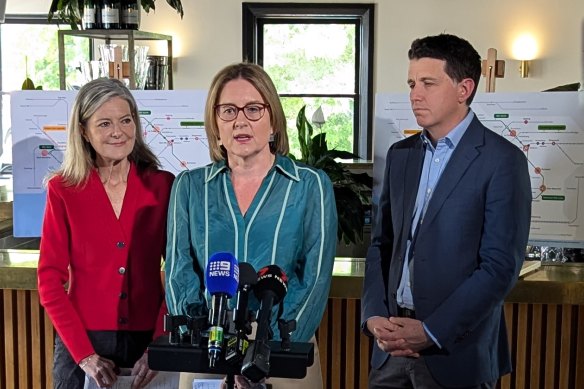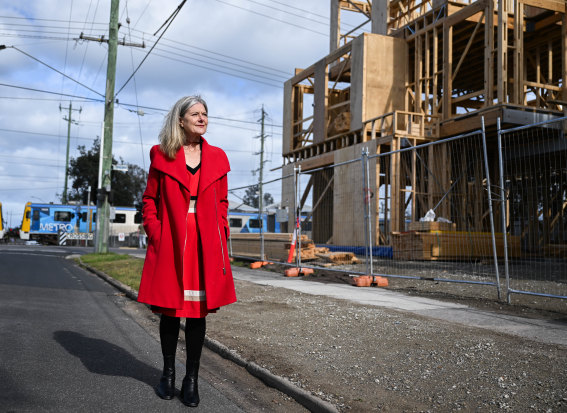Growing pains: In the week of Jacinta Allan’s housing policy, Victoria grew by about 3000 people. Is it too much?

Melbourne’s population will balloon to 10 million.Credit: ARTWORK Matt Davidson
Every three minutes, Victoria’s population increases by one person. In the six minutes or so it will take you to read this story, the state population will have ticked up by two; perhaps a young couple arrived from overseas with aspirations to start a family. In the six days since Jacinta Allan made her first in a flurry of big announcements about housing and planning, an additional 2880 people now call Victoria home. And one way or another, they all need somewhere to live.
According to the constantly ticking population clock published by the Australian Bureau of Statistics, Victoria has a population of more than 7 million people and in raw terms, is Australia’s fastest growing state.
Melbourne, depending on how you measure its boundaries, has already surpassed Sydney as Australia’s largest city. The Victorian premier this week pointed this out more than once, adding that by the midway point of this century, Melbourne will top 9 million people, the size greater London is today.
When Jacinta Allan talks about this, it is laced with excitement about the opportunities and challenges this will bring. As she describes it, welcoming so many people to the state and city is a good thing.

Premier Jacinta Allan, Planning Minister Sonya Kilkenny and Labor MP Ryan Batchelor announce 50 new activity centres to accommodate Melbourne’s housing needs.Credit: Kieran Rooney
“It is people voting with confidence that they see Melbourne and Victoria as a great place to live, a great place to raise their family, a great place to work,” she says. “We need to make sure we have got the homes, the infrastructure, the renewable energy that supports that growth.”
But how big does Premier Allan and her government want Melbourne to be? Does she envision a megacity of 10 million people, of 12 million, or more? Are we to be another London, or Los Angeles or New York? Is this what most of us want?
When these questions are put to the premier, she brushes them aside like a builder impatient to get on with their concrete pour. “This growth is happening now,” she says. “What we are saying very clearly this week is the opportunity that comes with this growth must come with the building of more homes.”
There is no dispute, whether in Melbourne, Sydney or south-east Queensland, that we need far more housing. Yet, beyond this week’s headlines about high-rise apartment blocks in middle suburbs, stamp duty giveaways, massive land releases on our suburban fringe and clearing the way for more subdivisions, there is an uneasy sense that Melbourne is speeding towards a place we don’t necessarily want to go, without anyone being at the wheel.
“I don’t want to live in a city as big as London,” says Matthew Guy, a former opposition leader and planning minister who first warned seven years ago that Victoria’s rate and city-centric pattern of population growth, where more than four out of five new arrivals settle in Melbourne, would render the city unlivable. “I don’t want Melbourne to be as big as London. I don’t know anyone who wants Melbourne to be a city of 8 to 12 million people. I don’t know anyone who was asked whether they want to live in a city of 8 to 12 million people.”
James Newbury, the Liberal member for Brighton, a bayside electorate that contains three of 25 new activity centres announced by the government as middle suburban sites near train stations earmarked for greater density housing development between now and 2051, is more pointed. “Fast, massive growth will come with a cost,” he says. “We cannot sacrifice Melbourne’s liveability for population growth. Jacinta Allan hasn’t asked Victorians whether they want to triple the state’s size, and she certainly doesn’t have a mandate for it.”
When it comes to population, it is a long time since any government, federal or state, quantified how fast or how far we should grow. This is the piece missing whenever we talk about housing, health, transport or education. Since the end of the Whitlam government, when Australia last held to its post-war goal of a 2 per cent annual population growth, neither Australia nor Victoria has had a population policy. Our last federal minister responsible for population, Tony Burke, nominally held the portfolio in the Gillard government but baulked at the idea of adopting either a population target or a preferred rate of growth.
Instead, the population clock is driven almost entirely by net overseas migration. Australia’s population, rather than being a considered area of national policy with a minister and government department responsible for delivering its aims, is a statistical byproduct from our annual intakes of skilled workers, family members of people already here, students, New Zealanders crossing the ditch and refugees.
Victoria, a state that expects to receive more than 400,000 overseas arrivals every five years, is left to deal with the downstream consequences, whether good or bad, without an overarching national policy about what Australia’s future size and shape should be.
Some of our smartest demographers offer different views on whether this is a serious problem.
Peter McDonald, Emeritus Professor of Demography at the Australian National University, points out that despite the absence of a population policy, the size of our permanent migration intake has been stable since the Gillard government. This indicates there is a tacit, bipartisan agreement about how many people we need to bring here to slow the ageing of our established population, provide the skills our economy needs and meet our humanitarian responsibilities.
He says the weakness in our immigration system – uncapped temporary skilled migration which is distorted by “visa-hopping” arrivals determined to remain in Australia permanently – would not be addressed by a population policy. “Controlling migration to a fixed number per annum is not as easy as some politicians would have us believe,” he says.
In the meantime, the likelihood that Victoria and Melbourne will continue to grow is forcing the Allan government to confront real and pressing issues, albeit later than they should have.
“Envisaged future population growth drives government to address this present problem – a good outcome. And it would be a far worse problem in the long term if the population growth did occur and government had not addressed that prospect. This is, in many ways, the story of Australian history with housing and infrastructure falling behind needs.”
Liz Allen, a demographer at the ANU’s Centre for Policy Research, says while it is not necessary and perhaps not even advisable for Australia to have a hard population target, we do need a population policy to make coherent today’s argument about housing, and the ones we’ll have tomorrow about transport, health services, schools and jobs.
“In order for a population policy to be effective it needs to have a holistic approach to population wellbeing,” she says. “That includes housing, education, health and employment. The only quasi-population policy we have is embedded in our immigration program. There is a clear need for a plan or blueprint for the future.
“Most Australians have a plan for where they want to be and what they want to be doing in five years. At a national level, we don’t have that. We have, in effect, a disjointed, disparate policy space.”
When it comes to housing, Allen is dismayed at where our big cities are. “This is a disaster in the making,” she says bluntly. “The lack of action and willful neglect of Australia’s housing system is hurting generations of Australians and pulling the rug out from under our future. The frustration for me is visceral. We see it in the data. No one can argue with this. It is an unquestionable catastrophe and the people that are making policy decisions lack the lived experience and necessary insight to fix it.”
Allen’s sense of despair reflects where she sits in Australia’s property divide. Having found a way through her own social disadvantage and disrupted schooling to become one of Australia’s leading demographers, Allen is a mid-40s working mother locked out of home ownership. She is emblematic of the problem the Victorian government is trying to solve. So far, she is unconvinced by the solutions on offer.
“There is great political strategy in designing a forward-thinking plan that has all the bells and whistles and no funding attached,” she says. “It is great for getting votes but what is being proposed here in Victoria is trying to put a bandaid on a bullet hole. It is not going to fix the crisis.
“There needs to be a whole-of-government response that sits with a minister or ministers to fix this problem. It sits across multiple policy portfolios and they need to work in concert with each other. There needs to be an overarching blueprint or plan for the future. But at the end of the day, if there is no funding assigned to it, it is not going to happen.”
The Allan government says this is precisely what it is doing through Plan for Victoria, a year-long project it will unveil at the end of this year, along with a further 25 suburban locations it has identified for higher density housing development. The plan is an attempt, ambitious in scale and intent, to reshape Victoria and Melbourne’s future growth by aligning new homes with jobs, transport, other services, people’s aspirations about how and where they want to live and the broader economic, environmental and social interests of the state.
The parliamentarian who is leading the project, Minister for Planning Sonya Kilkenny, says its policy proscriptions are informed by a basic question the government put to constituents, local governments and peak organisations in its consultations.
“We have never really asked the question of Victorians ‘where do we want to be, where do you see yourself in 2051’,” she tells The Age. “That is the question Plan for Victoria has posed.”
The answer should be apparent to anyone who listened to the premier this week. The clear message received by the government is that Melbourne is growing in a way that is neither fair nor equitable. People looking for a home don’t all expect to live in the highest priced suburbs, but they do want choices – whether it is for home ownership or renting – denied to them by tax arrangements that benefit investors, a scarcity of homes in places they would otherwise choose to live and the chasm between the cost of housing and the rent or mortgage repayments they can afford to pay.
Summarising what she describes as overwhelming community sentiment, Kilkenny says: “We see Victoria in 2051 as being a place where people can have a home where they want to live; whether that is close to the family, whether it’s with a backyard, whether it’s in established areas because I want to be close to the train or my school where I grew up with the family and friends that I’ve got there.”

Planning Minister Sonya Kilkenny is leading the government’s Plan for Victoria, a blueprint for future population growth.Credit: JOE ARMAO
It is reasonable for planning experts to be sceptical about whether the Plan for Victoria can alter the course of Melbourne’s population growth in the way the government hopes. Since 2002, we’ve had Melbourne 2030, Melbourne@5million, and various iterations of Plan Melbourne. All were boldly launched and quietly mothballed.
Kilkenny insists that, although her plan is intended to stimulate change over decades, there is a sense of urgency that the work must start. “We have got to do something. The system is not working. The status quo is not serving particularly young Victorians and it is just making it harder and harder for people to find a place.”
Further clues to Plan for Victoria can be found in work commissioned by Infrastructure Victoria, an independent body that advises the government on how to meet the state’s long-term infrastructure needs. In 2022, as Melbourne was emerging from the pandemic, which brought a temporary halt to population growth, Infrastructure Victoria commissioned a survey of more than 6000 households with moderate incomes in Melbourne, Geelong and Ballarat about the type of home they wanted to live in.
This survey informed a report published in October last year, titled “Choosing Victoria’s Future”, which explored the relative economic, social and environmental benefits and disadvantages of Melbourne continuing its current outward expansion – known as a dispersed city model – compared to four other models of city and regional population growth.
The model the government appears to have embraced is a compact city; a future where Melbourne’s inner and middle suburbs are studded with more than 100 highrise apartment towers, medium-density apartments and townhouses alongside standalone houses, and 80 per cent of Victoria’s population growth is accommodated in Melbourne’s established suburbs.
“It doesn’t have to be 20-storey towers everywhere,” says Infrastructure Victoria chief executive Jonathan Spear. “We are not saying that and I don’t think the government is saying that either. There will be some places that are well suited to high-rise apartments. Many places are better suited to mid-rise apartments and townhouses, particularly around transport hubs.
“Our advice for years has been that this is a housing choice people want and a much better use of the infrastructure we have got. It will save Victorians billions of dollars in investment and get us better social, economic and environmental results. This is not just about housing. It is about how we are going to live.”
The starting point for this suburban transformation shows how ambitious the government’s plans are. The same Infrastructure Victoria report that laid out the different models for development noted that in 2021, 56 per cent of Melbourne’s population growth had been accommodated in new suburbs on the fringe of the city and only 44 per cent in established suburbs. This latter figure was down 60 per cent five years earlier. The survey commissioned by Infrastructure Victoria also reveals where an opportunity to change this trend may lie.
The survey results showed that the lure of a detached home on a block of land in a new suburb, preferably with a garage, remains strong. Two thirds of respondents said they preferred a standalone house, compared to only 3.9 per cent who nominated a high-rise apartment. Within this group of people holding to the traditional Australian dream of house and land home ownership, a significant number, about 20 per cent, said they would be open to shifting closer in to the city, and into an apartment or townhouse, if they could find one at an affordable price.
These are the people the government has in mind when it talks about allowing more apartment blocks and townhouses in suburbs such as Brighton, Malvern, West Footscray or Mitcham. These are the people Jacinta Allan is talking to when she spruiks her ambition for Victoria to become Australia’s “townhouse capital”.
Liz Allen says the best news she can offer is that young Australians, despite the raw deal their generations have been dealt, have not given up on one day owning a home. Who among us thinks this will be more achievable, rather than less, when Melbourne is twice as big?
Start the day with a summary of the day’s most important and interesting stories, analysis and insights. Sign up for our Morning Edition newsletter.